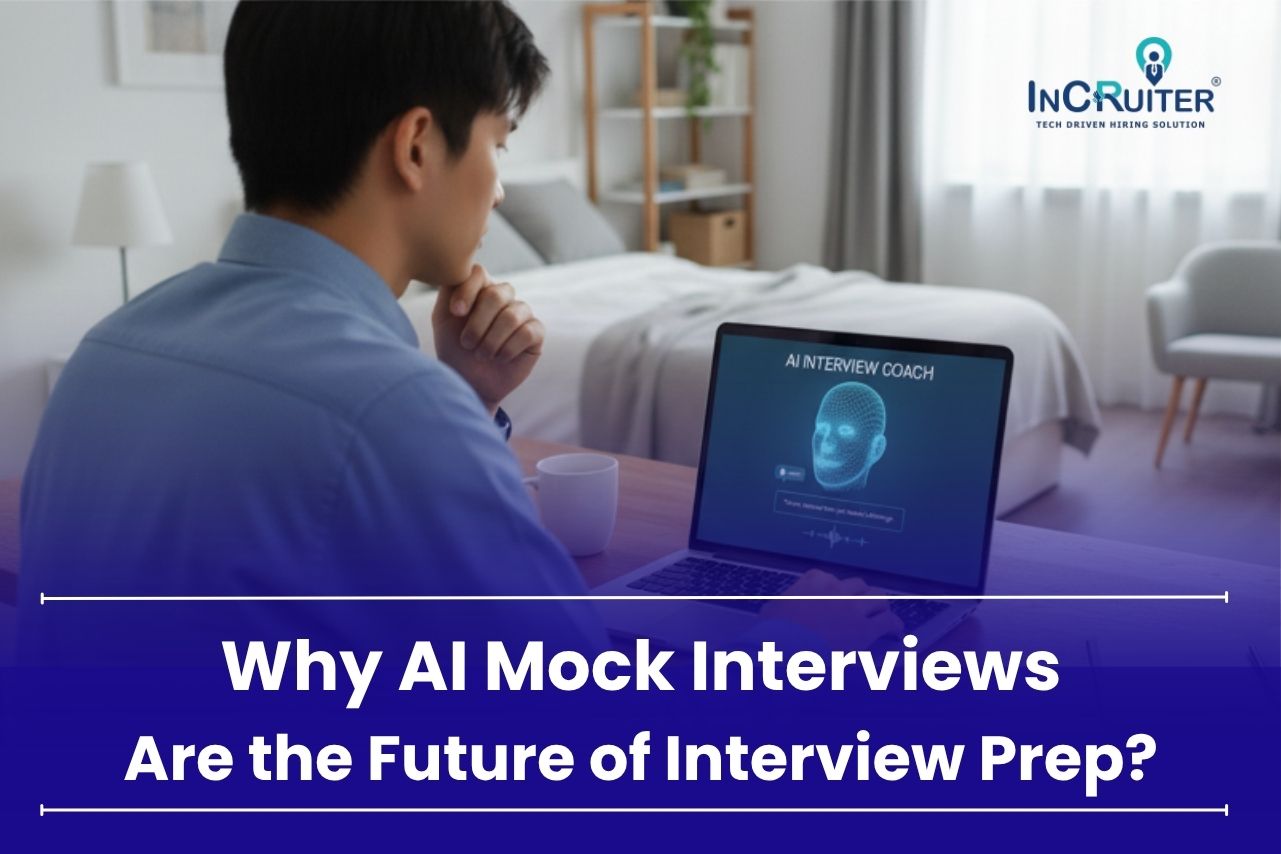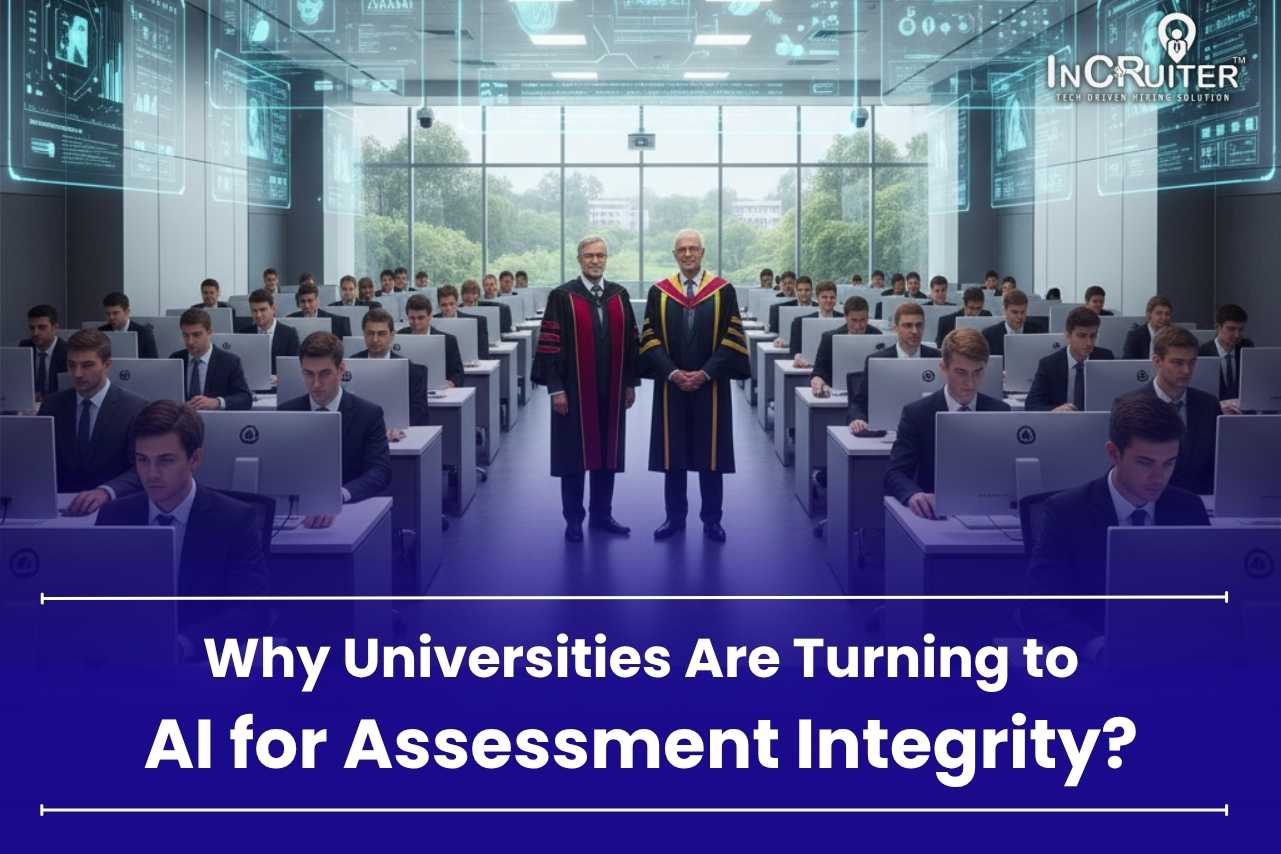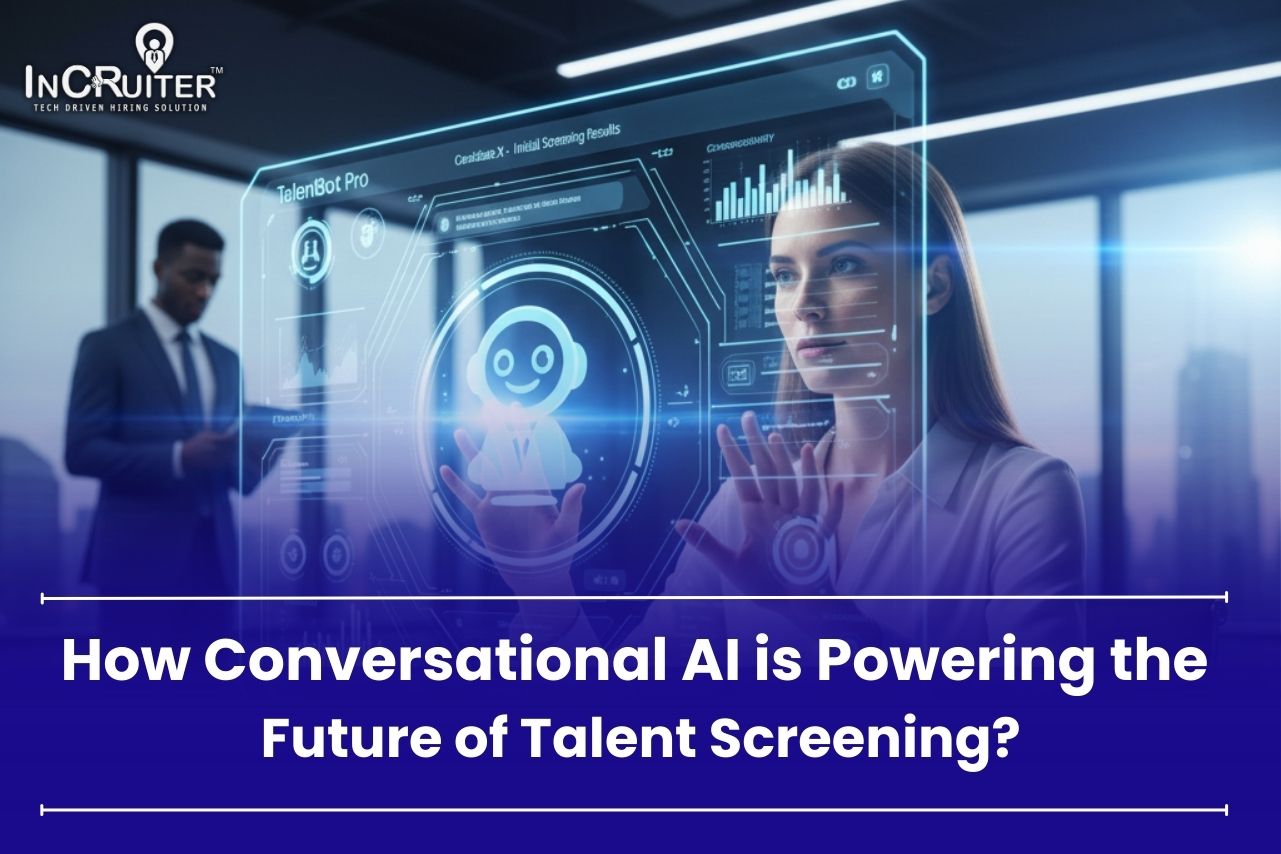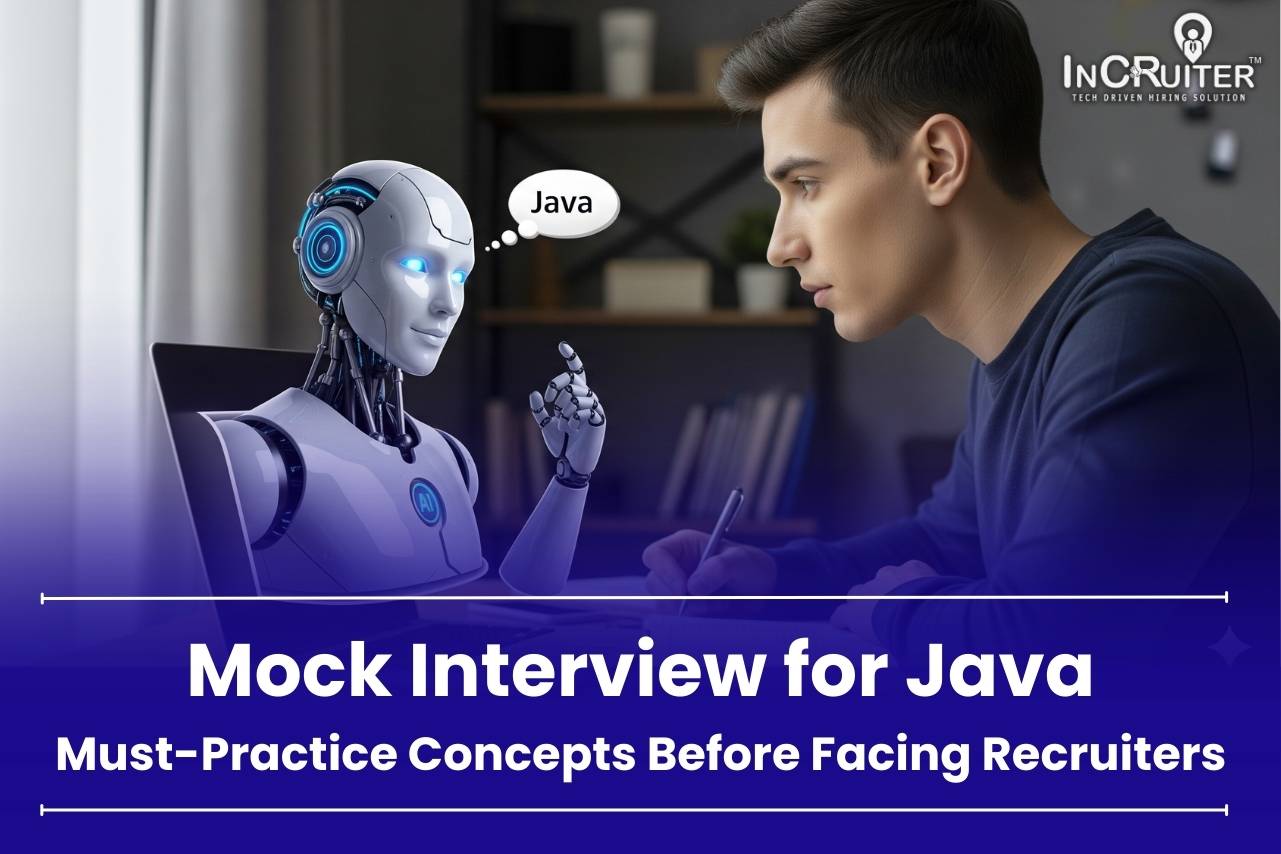Remote hiring has spawned a dangerous trend: proxy interviews, where imposters take interviews for candidates using fake IDs, voice changers, and remote access tools. This sophisticated fraud bypasses traditional screening, risking unqualified hires and security breaches.
But AI is revolutionizing detection. Advanced AI Video Interview Platforms now analyze eye movements, voice patterns, and typing behavior to expose fraud in real-time. Companies are enforcing strict punishment for proxy interviews, including blacklisting and legal action.
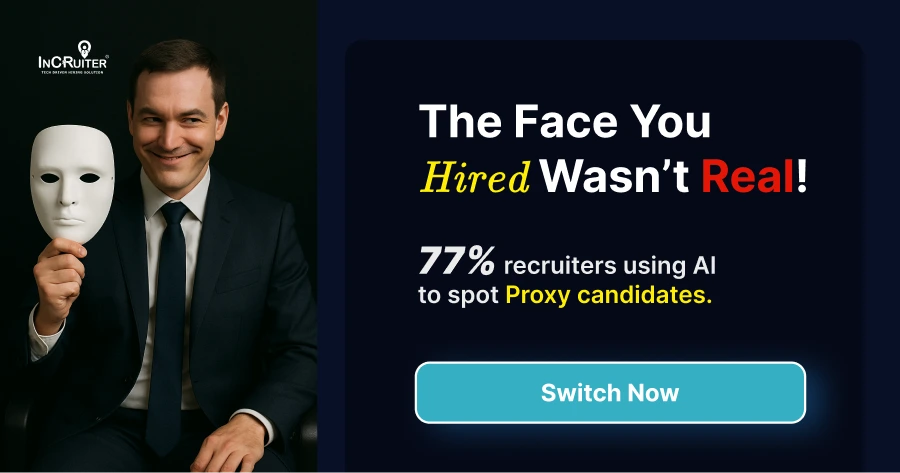
For candidates, the consequences outweigh any short-term gain. For employers, AI-powered proctoring ensures hiring integrity. The message is clear: proxy interviews are high-risk, and getting caught is inevitable.
This blog dives into how an AI interview tool detects and stops proxy interview tactics before they compromise your next hire.
What is a Proxy Interview?
A proxy interview is a fraudulent practice that a candidate gets someone else to attend the interview on their behalf. This could be a friend, a paid third party expert, or even a remote helper feeding answers live. It’s often used in technical roles where the candidate isn’t confident but still wants to clear the process, creating major risks for employers post-hiring.
Reason Behind The Growth Of Proxy Interview
Everyone wants to move into better roles with high pay in a short span of time, especially in trending fields like data science, cloud, and AI. As these job roles become more desirable, professionals from backgrounds like Java, Python, Software Testing, C, and C++ feel the urgency to switch fast.
But the job switch is not so easy.
Many understand the concepts but struggle with practical coding during interviews. Due to limited time for interview preparation and growing fear of rejection in the recruitment process, some candidates choose proxy interviews to clear the interview process. Remote format of the hiring process makes it easier for proxies to appear instead of the actual candidate
What seems like a quick fix is now a threat to hiring quality.
Beyond career switching, other factors are also fueling the rise of proxy interviews:
- Pressure to get hired quickly after layoffs or job gaps
- Returning to the job market after a long career break
- Facing repeated rejections in technical interview rounds
- Choosing shortcuts to avoid feeling slower than peers
Common Tactics Used by Candidates in Proxy Interviews
1. Faking Presence Using Video or Voice Alteration
Candidates sometimes simulate interview attendance using static videos during one-way or passive interviews. In audio-only calls, real-time voice changers like Voicemod help match expected accents or gender. These proxy interview tactics are used when minimal engagement is expected, relying on stable lighting and controlled environments.
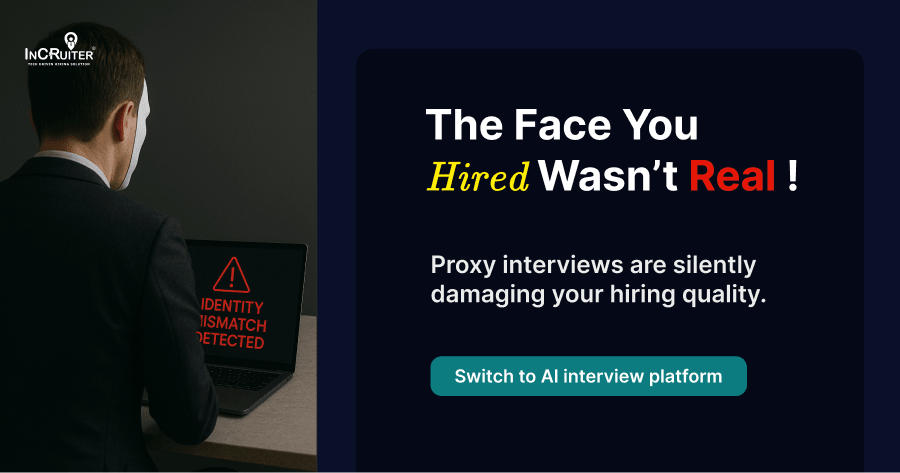
However, mismatched lip sync, facial stillness, inconsistent pitch, or inability to respond naturally to follow-up questions often reveal that the candidate on screen or call is not the one actively participating.
2. Receiving Live Help Through Remote Access
To bypass coding assessment rounds, some candidates give system access to a proxy using tools like AnyDesk or stream their screens through secondary devices or split displays. The proxy solves tasks in real time while the candidate copies inputs and pretends to think aloud.
This fraudulent practice is popular in high-stakes roles such as Data Scientist, Machine Learning expert, Blockchain developer, and Full-stack developer, where technical accuracy matters more than delivery. Unusual cursor movements, rapid code quality shifts, or delayed explanations often trigger suspicion during proxy interview attempts.
3. Using Earpieces for Real-Time Audio Assistance
In a live video interview proxy, hidden Bluetooth earpieces are used to receive answers from off-site helpers. The listener feeds responses as the candidate repeats them with a slight delay.
This type of Interview fraudulent practice is favored in non-technical roles like business analyst, marketing manager, project manager, HR manager, and sales manager, or when predictable questions are expected.
While subtle, signs like broken flow, mismatched tone, or inability to clarify responses when probed further can reveal external interference. Interviewers increasingly watch for unnatural pauses or robotic phrasing to catch this proxy interview behavior.
4. Showcasing Outsourced Technical Work
To strengthen resumes, some candidates present GitHub profiles filled with freelance-written code. These repositories often contain clean commits and structured documentation that appear impressive at first glance.
This method of fraudulent practice is typically used by those lacking real-world experience but seeking to meet screening thresholds. The gap surfaces when deeper rounds require the candidate to explain logic, dependencies, or debugging history areas where only the original developer can confidently respond.
5. Replacing the Candidate with a Proxy
In remote hiring, particularly for freelance or contract roles, some candidates have a proxy to attend the interview using borrowed credentials and altered IDs. The proxy studies the resume, rehearses answers, and appears on camera posing as the applicant. This tactic exploits systems that rely on static ID uploads without video-based verification. It often unravels when asked spontaneous personal questions, when the interview proxy fails to mimic expected speech patterns, or when subtle facial mismatches raise red flags.
Best Ways To Spot The Fake Proxy Candidates
As remote interviews grow, so does the risk of proxy interview fraud. Candidates may appear qualified on paper but rely on external help or impersonation during assessments. These practical, technology-backed methods help recruiters identify fake participants and ensure the person interviewed is the person hired.
1. Assess Verbal and Visual Synchronicity
A candidate’s communication should reflect natural human interaction. Delays between audio and facial movements, lack of expressions, or mismatched energy often hint at proxy interviews and real-time voice manipulation instead of genuine live presence.
- Lip-Sync and Audio Delay Check
Lip-sync issues often arise when candidates rely on voice changers or relayed prompts. Delays between speech and mouth movement, flat tone, or unnatural pacing can become noticeable. To mask this, they may blur video or cite technical issues during live interviews.
- Facial Microexpression Analysis
Natural speakers blink, frown, and smile reflexively. A lack of expression or a frozen look often signals that someone is mimicking or not actually responding in real time. Faking these small behaviors accurately is challenging for a proxy interview attempt.
2. Monitor Real-Time Coding Interaction
Candidates who truly know how to code can demonstrate ownership of their work during live sessions. Watching how someone types, navigates code, and reacts to real-time changes helps uncover whether they’re solving independently or just repeating what’s being relayed from a proxy.
- Cursor Movement Consistency
Candidates genuinely involved in problem-solving naturally align cursor movement with their thought process. Sudden or robotic movement that doesn’t follow their narration may indicate that another person controls the screen behind the scenes during the coding assessment test.
- Typing Rhythm Observation
A candidate’s typing speed typically varies during the thinking and typing phases. A consistent pace or large code blocks appearing too quickly can suggest pasted input or remote execution, breaking the illusion of solo problem-solving.
- Reaction to On-the-Spot Errors
Unexpected errors test a candidate’s thinking under pressure. Genuine applicants usually pause, analyze, and begin debugging. A proxy interview dependent candidate may panic, delay, or remain silent due to a lack of real engagement with the task.
3. Validate Knowledge Under Pressure
Proxies can rehearse scripts, but they can’t replicate real, adaptive thinking. Prompting candidates with follow-up questions, scenario changes, or logical cross-links can quickly expose whether their knowledge is authentic or being guided externally.
- Ask Uncommon Follow-Ups
Unscripted, job-specific questions force candidates to apply context and experience, not memorized responses. Hesitation, vagueness, or attempts to change the subject often indicate reliance on someone else’s preparation.
- Force a Mid-Logic Change
Modifying the problem mid-way disrupts rehearsed answers. Real candidates adjust naturally. Those relying on a proxy interview will either freeze, delay response, or struggle to justify a revised approach due to broken coordination.
- Use Concept Link Tests
Asking candidates to connect two unrelated concepts challenges their depth of understanding. A third-party interview proxy may miss these connections or answer in a generic way, exposing gaps in actual subject knowledge.
4. Examine Candidate’s Digital Trail
Resumes can be dressed up, but digital behavior often tells the truth. A genuine candidate can navigate, explain, and align their online footprint with their stated experience. A proxy interview, however, usually avoids in-depth discussion of past work.
Compare GitHub and LinkedIn activity with what’s mentioned in the resume. If project timelines don’t add up or there’s a sudden spike in contributions only during the hiring period, it suggests activity was staged or externally handled.
5. Detect Environmental Inconsistencies
Sometimes, the clues aren’t in what’s said, but in what’s seen or heard. Environmental mismatches, unusual device behavior, or inconsistencies in identity context often signal proxy intervention or substitute taking the interview.
- Mismatch Between ID and Background
Ask for ID verification on video. If the person’s location(IP address), accent, or surroundings don’t align with their documents or resume claims, it may suggest impersonation or proxy interview attendance.
- Voice Acoustics vs. Environment
The audio tone should match the setting. For example, if the background appears silent but echoes suggest a speakerphone, or another whisper is audible, it’s likely that a substitute is helping nearby.
- Device Switching Mid-Session
Sudden disconnections or changes in voice, video clarity, or lighting may indicate the session has been handed off to a different person. This is a common trick when the original applicant can’t keep up.
5 Proxy Interview Questions to Spot Fake Candidates
These questions are designed to expose candidates relying on external help. They require spontaneous, nuanced answers that proxies struggle with:
- “Walk me through your GitHub commit history for [specific project].” (Proxies often lack deep familiarity.)
- “What’s one limitation of the solution you just proposed?” (Tests self-critical thinking.)
- “How would your approach change if [constraint] were removed?” (Forces adaptive reasoning.)
- “Explain this concept to me like I’m a beginner.” (Reveals true understanding.)
- “What’s a mistake you made in a past project, and how did you debug it?” (Proxies avoid specifics.)
How AI Interview Software Detects and Prevents Proxy Interviews?
AI proctoring technology combines real-time monitoring, behavioral analytics, and automated decision-making to maintain the integrity of the online hiring process. Here’s how it works across different stages of the interview:
1. Verify Candidage Identity
Before the interview begins, the candidate receives a secure private interview link. They enter their name, phone number, and email, which the system verifies against recruiter-submitted details. The one-way or two-way interview will proceed only if the information matches the system.
2. Candidate Behavioral Analysis
- Eye and Head Movements:
The AI actively tracks eye direction, blinking patterns, and head tilts to detect signs of distraction or reference-checking. For instance, if the candidate repeatedly looks to the side or down, it flags the activity for potential use of external materials in the hiring process.
- Dual Audio Detection:
The system continuously scans for voice irregularities, background conversations, and unnatural tone variations. If another person whispers answers or a voice assistant is in use, the AI raises a warning in real time.
- On-Screen Activity:
AI interview tools track all screen movements, including cursor behavior, tab switching, and keyboard usage in the interview process. If an applicant switches between different IDEs and windows to browse answers or attempts to paste copied content, the proctoring system flags these actions as violations.
3. Real-Time Alerts
AI monitors all interview data live and sends immediate alerts to the interviewer’s screen when it detects suspicious behavior. This allows human observers to pause the session, initiate a verification check, or mark the interview for review.
4. Object Detection
AI-powered video analysis can identify unauthorized objects such as smartphones, notepads, books, or extra screens in the candidate’s frame. It also monitors if someone enters the room, helping catch any form of third party proxy interview assistance.
5. IP Address Tracking
The proctoring system tracks the IP address, device location, and login environment to confirm whether the candidate appears from a verified location. Use of VPNs or remote desktop software can trigger location mismatch alerts.
6. Detailed Proctoring Logs
Once the interview concludes, the AI generates a comprehensive feedback report that includes various logs such as facial data, voice activity, screen usage, and incident logs. These insights help recruiters evaluate candidate honesty and understand if poor performance was due to cheating or genuine difficulty.
Tips to Choose AI Interview Software To Prevent Proxy Interviews
- Choosing the right AI interview software is critical to prevent proxy interviews. The best solutions use AI-powered proctoring to detect fraud through real-time monitoring of eye movement, background noise, and unusual pauses.
- Features like screen recording, tab-switching detection, and secure browser lockdown prevent candidates from seeking external help. Behavioral analytics flags inconsistencies in speech patterns or facial expressions, while randomized, adaptive questioning makes the third-party proxy interview harder.
- Leading platforms like InCruiter AI Video Interview Platform integrate these legal safeguards. To maintain hiring process integrity, always verify the software’s fraud detection accuracy through testing before full implementation.
Success Stories of InCruiter AI Interview Software
InCruiter’s AI Interview Software has successfully helped medium and large enterprises streamline the hiring process and reduce proxy interview fraud across high-volume recruitment drives.
One IT services firm reported up to a 40% drop in proxy candidate attempts within 1 month of integrating InCruiter’s AI-Proctored Video Interview Tool.
A BFSI client improved screening accuracy by 4x, using automated interview scoring to shortlist genuine candidates faster.
Startups also benefited by saving 80% hours per hire through automated interview scheduling and AI-led coding assessments. InCruiter’s AI interview solution is now trusted by 500+ companies to ensure skill-based, identity-verified hiring across tech and non-tech roles.
Conclusion
Identifying proxy candidates is critical to protecting the quality and trustworthiness of your hiring process. As proxy interview fraud grows more sophisticated, traditional methods fall short. AI-powered interview software offers a more innovative way forward, automatically tracking candidate behavior, verifying identity in real time, and automatically flagging anomalies. It ensures only genuine applicants make it through.
Don’t let third-party proxy interviews become proxy jobs. Protect your team with AI that stops proxy hiring and early employment. Book a demo with the InCruiter team to close the fraud loop.
Frequently Asked Questions:
Can AI accurately detect fake candidates in real-time?
Yes, AI can accurately detect fake candidates in real-time when integrated with advanced proctoring features. Modern AI interview platforms use facial recognition, authenticity checks, behavior analysis, and system monitoring to spot signs of impersonation or third party proxy interview support.
From detecting multiple faces to tracking off-screen activity, AI ensures only the genuine candidate is assessed, making the hiring process smarter, faster, and more secure.
How does InCruiter’s AI differ from others in proxy detection?
InCruiter offers a full-stack virtual interview solution built specifically for recruitment, not just assessments. Unlike generic proctoring tools, it combines real-time live interview proxy monitoring, continuous face detection, and candidate presence tracking.
The AI Video Interview Platform auto-captures anomalies like face mismatch or screen absence and sends alerts instantly. With recruiter-friendly workflows and detailed session reports, InCruiter focuses on stopping third-party proxy interviews without adding complexity to your hiring process.
Is AI interview software suitable for all industries?
Yes, AI interview software is suitable across all industries where candidate verification, skill assessment, or remote hiring is involved. Sectors like IT, BFSI, BPO, healthcare, education, logistics, and retail use it to screen large volumes efficiently.
Whether hiring developers, sales reps, support agents, or trainers, AI ensures genuine participation, reduces manual effort, and standardizes interviews, making it adaptable for both technical and non-technical roles across entry to senior levels.
What’s the cost of implementing AI interview software?
AI interview software is designed to be cost-efficient, often reducing recruitment related expenses by up to 90% and, in some cases, even more. Most Online interview service platforms offer flexible plans, including pay-per-interview or monthly subscriptions based on usage.
Many providers also offer a free demo so teams can evaluate the system before committing. Compared to the cost of manual screening or a wrong hire, AI interview software is a highly economical solution.















